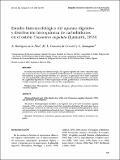Por favor, use este identificador para citar o enlazar a este item:
http://hdl.handle.net/10261/43380COMPARTIR / EXPORTAR:
 SHARE
BASE SHARE
BASE
|
|
| Visualizar otros formatos: MARC | Dublin Core | RDF | ORE | MODS | METS | DIDL | DATACITE | |

| Título: | Estudio histomorfológico del aparato digestivo y distribución histoquímica de carbohidratos en el ostión Crassostrea angulata (Lamarck, 1819) (Histomorphological study of the digestive tract of the oyster Crassostrea angulata (Lamarck, 1819), and distribution of carbohydrates) |
Otros títulos: | Histomorphological study of the digestive tract of the oyster Crassostrea angulata (Lamarck, 1819), and distribution of carbohydrates | Autor: | Rodríguez de la Rúa, Ana; González de Canales, María Luisa CSIC; Sarasquete, Carmen CSIC ORCID | Palabras clave: | Histoquímica Carbohidratos Glucogéno Glicoproteínas Moluscos bivalvos Crassostrea angulata Histochemical Carbohydrates Glycogen Glycoproteins Bivalve molluscs |
Fecha de publicación: | 2002 | Editor: | Instituto Español de Oceanografía | Citación: | Boletín del Instituto Español de Oceanografía 18(1-4): 329-336 (2002) | Resumen: | [EN] We present a histomorphological description of the digestive tract of the oyster Crassostrea angulata (Lamarck, 1819), as well as a histochemical study of its carbohydrate distribution. The study shows that, in general, glycogen is found in the connective tissue, and neutral mucopolysaccharides/glycoproteins and/or
acid mucosubstances in the epithelium and basal cell layers. Glycogen was not detected in the digestive gland, possibly because of its mobilization to the connective tissue for reproduction. [ES] Se realiza una descripción histomorfológica del aparato digestivo del ostión Crassostrea angulata (Lamarck, 1819) y se pone de manifiesto la distribución de carbohidratos mediante técnicas histoquímicas. La pauta general observada es la presencia de glucógeno en el tejido conjuntivo y de mucopolisacáridos/glicoproteínas neutras y/o ácidas en las membranas basales y el epitelio. En la glándula digestiva no se observa glucógeno debido, posiblemente, a su movilización hacia el tejido conjuntivo para su posterior uso con fines reproductivos. |
Descripción: | 8 páginas, 1 figura, 3 tablas. VIII Congreso Nacional de Acuicultura: Acuicultura y desarrollo Sostenible (2001, 22-25 mayo, Santander) | Versión del editor: | http://www.ieo.es/publicaciones/boletin/pdfs/bol18/18(1-4)329-336.pdf | URI: | http://hdl.handle.net/10261/43380 | ISSN: | 0074-0195 |
| Aparece en las colecciones: | (ICMAN) Comunicaciones congresos |
Ficheros en este ítem:
| Fichero | Descripción | Tamaño | Formato | |
|---|---|---|---|---|
| Crassostrea angulata_2002.pdf | 351,4 kB | Adobe PDF |  Visualizar/Abrir |
CORE Recommender
Page view(s)
370
checked on 24-abr-2024
Download(s)
445
checked on 24-abr-2024
Google ScholarTM
Check
NOTA: Los ítems de Digital.CSIC están protegidos por copyright, con todos los derechos reservados, a menos que se indique lo contrario.
